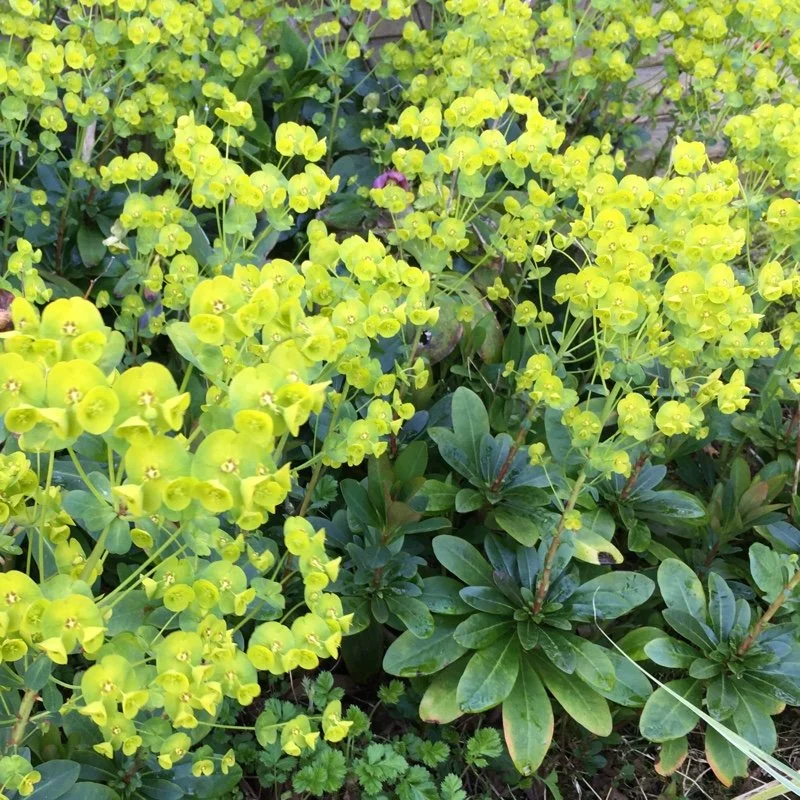The zesty world of euphorbia
/I have noticed more than once in this gardening adventure that I can be thoroughly blind to a plant, and then whammo – I tune in, and it’s everywhere!
After four days spent roaming the gardens of the Hurunui Garden Festival recently, I can say that I now firmly have my spotlight trained on euphorbia in all its wonderful, zesty forms.
Not only had I lacked awareness of it, I also totally underestimated the energy it brings to the mid-spring show.
Euphorbia characias subsp. wulfenii at Flaxmere Garden
Euphorbia is an enormous and diverse plant family that is commonly referred to as ‘spurge’ with species hailing from Africa and Europe to the Americas. Confusingly for everyday gardeners, plants like poinsettia and some distinctly cactus-like species can be collected under the genus, however, they all share the common trait of leaking a milky latex when broken or cut.
This is generally considered poisonous, and while I had no problems wiping stray dots of it off my hands while picking, the story of it flying into someone’s poor eye has definitely made me wary when handling it.
Plants involved in the euphorbia family range from annual and biennial to herbaceous perennials and woody shrubs. Some species can be particularly succulent-like with bandy long arms or fleshy foliage while others are softer and lower, forming gentle mounds.
So many of these plants solve problems in the garden by being softly spreading, receptive of full sun and part shade and, once established, very tolerant of dry conditions. Aside from the odd deadhead and patrolling for over-enthusiastic seeding, they can be considered low maintenance.
Euphorbia characias subsp. wulfenii
Perhaps the most widely recognised euphorbia on our shores is the scopey and Seuss-like Euphorbia characias subsp. wulfenii that offers year-round interest with its rangy limbs topped with large, lime green puffs of inflorescence in spring through summer.
Once finished, flowers can be pruned back to the base of their stems and the attractive silvery green foliage continues to provide interest all year round. A slightly less shouty member of the family would be Euphorbia characias ‘Silver Swan’ that has extraordinary muted silver flowers and foliage.
I can honestly say that I hadn’t really paid much attention to the herbaceous euphorbias that offer such interesting ways to introduce colour and shape to our gardens. On my wandering of the Hurunui gardens and the burgeoning spring border at the Christchurch Botanic Gardens, I made it my mission to stop and appreciate these beautiful plants that sway between soft filler and star of the show.
Euphorbia polychroma at The Blue House
Low and gently mounding Euphorbia epithymoides or polychroma, aptly known as ‘Cushion Spurge’, held pride of place in The Blue House garden in Amberley, where it was selected for both its hardiness to the dry and self-shading form, not to mention its well-defined golden yellow flowers, which dotted themselves over the dome-shaped foliage.
Also spotted on my travels were the very attractive blooms of Euphorbia x martinii, known as ‘Martins Spurge’, which sport softly rounded towers of chartreuse green, studded with burgundy centres within the open sprays of flowers.
Euphorbia x martinii
Euphorbia species at The Blue House
Euphorbia griffithii was a distinct contrast to its lime green cousins with hot-coloured blooms that sit atop dark stems, its muted green leaves ribbed with red. Look out for varieties like ‘Dixter’, ‘Wickstead’ and ‘Fireglow’, which vary slightly between each other in mature height, intensity of the bloom colour and leaf tone. It appears all like to spread out amongst another planting so keep an eye on it.
Euphorbia griffithii ‘Dixter’
And speaking of merry self-seeders, common Euphorbia amygdaloides var. robbiae will be a familiar sight to many with its cheerful crop of (what should now be named) ‘euphorbia green’ blooms. Even though it’s eager, it will bring a glow to those tricky dry shade areas, and, if allowed, will form a thigh-height ground cover.
Euphorbia amygdaloides var. robbiae
Image SourcE
As I researched and attempted to identify the euphorbia I had observed, it became rapidly apparent that my list here only touches on the varieties available for us to experiment with here in New Zealand.
I urge you to keep your eyes peeled for those distinctive graphic blooms and consider offering them a spot in your own garden.
This is an expanded version of the article featured in my Stuff ‘Homed’ gardening column for beginners , The Press, Dominion Post and other regional papers on November 10th 2022
All words and images are my own, unless otherwise credited.









